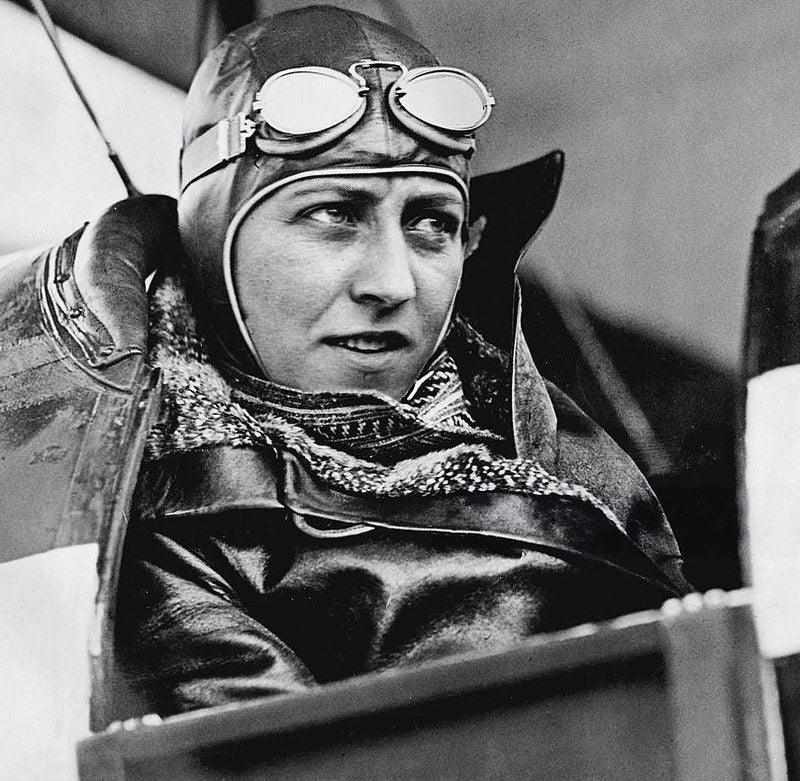The Flying Debutante
On February 23, 1901, a little girl was born to Erickson Norman Nichols and Edith Corlis Haines in New York City. Her father was a New York Stock Exchange member and served with Teddy Roosevelt's Rough Riders.
She lived a privileged life, attending a private preparatory school in New York City, and graduating from high school in 1919.
Her father's graduation present to her was an airplane ride with Eddie Stinson Jr., igniting her interest in aviation.
Ruth Rowland Nichols, the Flying Debutante, secretly took flying lessons while a student at Wellesly College and studying pre-med. As she continued her flying lessons, she soloed in a flying boat.
Shortly after graduation, she became the first woman to obtain a hydroplane license (Originally, seaplane aircraft were called Hydroplane aircraft).
Four years later, in January of 1928, she co-piloted an aircraft with her flying instructor on the first non-stop flight from New York City to Miami, Florida. They flew a Fairchild FC-2 aircraft.

A Fairchild FC-2 aircraft similar to the one flown by Ruth Nichols and Harry Rogers in 1928.
Aviation Career
After her flight to Miami with Harry Rogers, her flight instructor, she became known as the Flying Debutante (a name she hated) because of her aristocratic family background.
As a result, she was then hired as a sales manager for the Fairchild Aviation Corporation.
In 1929, along with Amelia Earhart and others, she helped found the Ninety-Nines, an organization of licensed women pilots.
In August of 1929, she and Amelia Earhart participated in the first Women's Air Derby (now known as the Powder Puff Derby).
The race was from Santa Monica, CA, to Cleveland, OH, but en route, Ruth crashed, Louise Thaden won the race, and Amelia Earhart finished third in the heavy class.
Record-Setting Flights
During the 1930s, Ruth Nichols continued her aviation pursuits setting several records flying a Lockheed Vega, the New Cincinnati, loaned to her from a millionaire radio industrialist named Powel Crosley, Jr.
In December of 1930, she beat Charles Lindberhg's Los Angeles to New York record, finishing the flight in 13 hours, 21 minutes, and 45 seconds.
She set the women's altitude world record in March of 1931, attaining and altitude of 28,743 feet, followed by the women's speed record of 210.7 mph.

Ruth Nichols standing beside the Lockheed Vega 5 in which she set all of these records.
Ruth Nichols was the only woman to simultaneously hold the women's world speed, altitude, and distance records for heavy land planes.
On October 21, 1935, Nichols was seriously injured in the crash of a Curtis Condor aircraft in which two couples were to wed flying over New York City.
The aircraft crashed shortly after takeoff, killing the pilot and Nichols, sustaining a broken left wrist, ankle, nose, contusions, and burns. She was unable to fly for nearly one year.
World War II
World War II saw Nichols heading up Relief Wings, a civilian air service that performed relief flights and assisted the Civil Air Patrol during the war.
Eventually, Nichols would attain the rank of Lieutenant Colonel in the Civil Air Patrol.
Following the war, Nichols continued fling for humanitarian efforts such as Save the Children and the International Refugee Organization.
In 1958 she lobbied the USAF for permission to co-pilot a TF-102A Delta Dagger aircraft to a speed of 1,000 mph and an altitude of 51,000 feet.
Following that, she applied for NASA's Mercury program and underwent the same isolation, centrifuge, and weightlessness test as the other astronaut candidates.
At that time, there was some interest in women's suitability as an astronaut.
Nichols did not pass all of the Phase 1 tests that the other women did, although she performed well enough to urge Air Force scientists to include women in their spaceflight programs.
Death
Sadly, on September 25, 1960, Nichols passed away as the result of an overdose of barbiturates at her home in New York City.
During her incredible career, she flew every type of aircraft developed, including the dirigible, a glider, an autogyro, seaplanes, biplanes, triplanes, transport aircraft, and supersonic jets.
In 1992 Nichols was posthumously inducted into the National Aviation Hall of Fame.
A propeller from her 1930s Lockheed Vega is on display in the Golden Age of Flight gallery of the National Air and Space Museum.
I hope you enjoyed this trip through some of the history of aviation. If you enjoyed this trip, and are new to this newsletter, sign up to receive your own weekly newsletter here: Subscribe here:
Until next time, keep your eyes safe and focused on what's ahead of you, Hersch!







Leave a comment
This site is protected by hCaptcha and the hCaptcha Privacy Policy and Terms of Service apply.